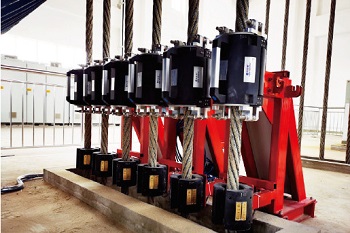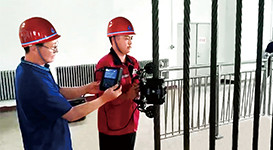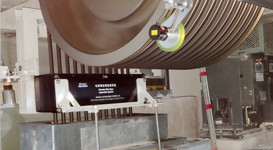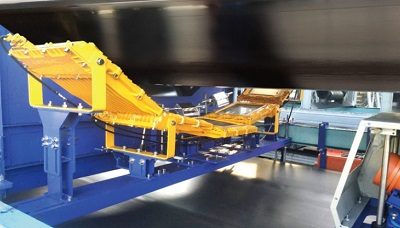
|

|

|

|
Steel wire ropes are widely used in many important fields of the national economy, but there are still some world-wide problems such as prominent safety hazards, poor economy, and serious accident hazards in the use of steel wire ropes. At present, there are still many users in the domestic coal system who continue to use manual inspection methods for steel wire rope safety management. Manual inspection has many drawbacks, which has resulted in many transportation accidents and serious injuries in the coal system over the years.
There are the following difficulties in the use of steel wire ropes for lifting winches.
(1) Unsafe. There is a risk of accidents due to decreased strength. A leading research institution in the United States conducted a statistical analysis of more than 8,000 laboratory and field records of steel wire ropes. The conclusion was that about 10% of the steel wire ropes in use had a strength reduction of more than 15%, which was in a dangerous state; another 2% or more of the steel wire ropes had a strength reduction of more than 30%, which was in an extremely dangerous state. However, the survey results in the United States showed that about 70% of the steel wire ropes that were forced to be replaced had only a small or even no strength reduction.
(2) Not economical: Regular replacement of steel wire ropes causes tremendous waste. Statistics from Japan show that more than half of the steel wire ropes that are compulsorily replaced have a strength of over 90% of the new rope strength, and many have a strength of over 100%, which means they are still in the break-in period.
(3) Low efficiency: Manual visual inspection and hand-touch inspection generally only allow the steel wire rope to operate at a speed of less than 0.3 m/s, and those steel wire rope sections with heavy oil sludge can only be inspected after being cleaned. And each shift or day needs to be inspected once. Each inspection takes about 1 hour, and 1 year will waste 300-400 hours.
(4) Unscientific. Manual inspection can only detect external damage to the steel wire rope, but cannot detect internal broken wires, wear, corrosion, and especially fatigue. Therefore, many major hidden dangers are difficult to detect.
(5) Serious wire rope breaking accidents can lead to extremely serious consequences: ① personal injury and death; ② equipment damage; ③ work stoppage; ④ repair costs; ⑤ legal liability; ⑥ and a series of other problems.
To ensure the safe operation of steel wires, countries around the world have formulated strict safety inspection standards for the use of steel wires. China's government has included lifting, lifting, transportation, and load-bearing equipment in the special equipment management sequence, and clearly stipulated that the steel wire of lifting machines, passenger ropeways, elevators, cranes, and other equipment must be regularly inspected. The national coal production safety regulations clearly stipulate that the number of broken wires in one twist distance exceeds 5% of the total number, and the cross-sectional area of broken wires exceeds 10% of the total cross-sectional area, which means that it is scrapped.
In order to solve the problem of safe use of steel wires, experts from various countries have conducted research for more than 100 years and developed more than 10 types of steel wire detection methods. However, these methods cannot solve the problem of quantitative detection of steel wires and are therefore difficult to widely use in practice. Currently, the "Hall element detection method" and the "induction coil detection method" commonly used in China and foreign countries can partially detect the surface damage of steel wires in specific working conditions, but due to technical difficulties, they cannot accurately detect internal and external damage to steel wires, especially fatigue status, and therefore are rarely used in practice by users.
The emergence of the TCK.W steel wire rope damage quantitative detection system has made it possible to replace manual detection of steel wire ropes with scientific instruments. The TCK.W steel wire rope damage quantitative detection system uses sensors based on the principle of "spatial magnetic field vector synthesis" to accurately quantitatively detect the internal and external wire breaks, wear, corrosion, damaged cross-section, deformation, metal cross-sectional area reduction, and even the degree and location of steel wire rope damage such as steel wire welding points. It can also accurately detect the fatigue degree of the steel wire rope, which is currently impossible for all other types of detection equipment.
The TCK.W detects the steel wire rope damage situation by analyzing the spatial magnetic field vector status inside and around the steel wire rope. The TCK.W is the only device that uses weak magnetic technology to complete the detection of steel wire rope. Due to the very stable characteristics of the residual magnetic field of steel wire rope itself, in addition to the computer intelligent automatic calibration and reference zeroing technology used in this system can automatically eliminate various spatial interference magnetic fields (such as the geomagnetic field), ensuring the authenticity and reliability of extracting the original damage signal; at the same time, the TCK.W also design equipped with "signal fidelity module" and "anti-jamming module" and other technical devices, which can ensure the stability and accuracy of the detection results. The TCK.W detection system can not only display the on-line detection process, but also instantly print out the detection results. In addition, it can complete the wired and wireless information transmission connection with the PC, achieving remote monitoring and measurement of steel wire rope.
The sensitivity of this sensor is extremely high, 250,000 times higher than the current German-produced "Hall element" and 71,400 times higher than the current American-produced "integrated amplification Hall component".
In addition to its technical specifications surpassing similar international products, the TCK.W is equipped with an automatic calibration system and an environmental interference elimination system, which are important features not available in similar domestic and foreign equipment. This system can automatically search for different types of steel wire ropes and find the calibration position, enabling the TCK.W steel wire rope damage quantitative detection system to fully realize intelligent operation and human-machine dialogue. At the same time, the TCK.W completes a series of detection methods that are extremely simple to operate.
Due to a major breakthrough in detection principle, the TCK.W wire rope detector not only has multiple functions, high accuracy, fast testing speed, and strong anti-interference performance, but also has a small size, light weight, and convenient installation and card loading, making it a versatile quantitative damage detection system.
In summary, the nondestructive testing technology of steel wire rope plays an important role in improving the use and maintenance of steel wire rope. It provides technical support and basis for the scientific and systematic management and use of steel wire rope, ensuring the safety production of mines, reducing the labor intensity of employees, improving work efficiency, eliminating potential safety hazards, and ensuring the rational and economic operation of lifting equipment. Its promotion and use in Datong Coal Mine Group Company has proved that it is simple to operate, saves time in testing, and has intuitive and clear monitoring results. It is suitable for use in coal mines and is an ideal and practical steel wire rope flaw detector.
上一篇: Discussion on the safety supervision mode of steel wire rope for modern mine hoist
下一篇: Upgrading the on-line automatic monitoring system for winch wire rope
The application of TCK.W wire rope detection technology in academic journals
Editor's note: TCK.W has developed a weak magnetic rope detection technology that can real-time monitor the status of steel ropes 24 hours a day, 365 days a year, and locate, classify, and quantitatively identify various internal and external defects. Currently, more than 2,500 clients in 42 countries worldwide are using this technology. These clients have published papers on the safety and economic benefits brought about by this new technology in various academic journals. Here is a compilation of some of these papers for experts and scholars to explore and study in depth.。
论文名称
作者单位

 publish:《Datong Coal Mine Group》
publish:《Datong Coal Mine Group》